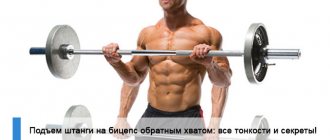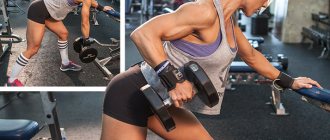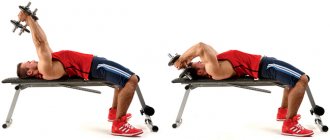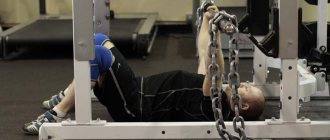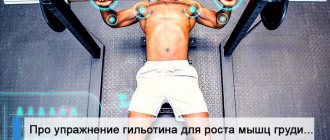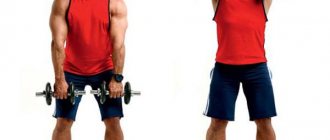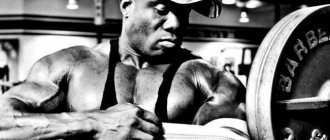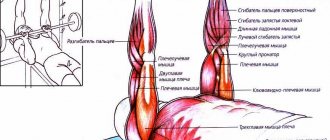What muscles does the reverse grip bench press work?
The main part of the load in the bench press with a reverse grip falls on the upper
(clavicular)
part of the pectoral muscles.
It is due to their contraction that the initial phase of lifting the barbell upward occurs.
Next, the front heads of the deltoids .
And the last to be included in the work are
the triceps
.
Due to their reduction, the “pressure” phase occurs. Also, when performing this press, the biceps
. It can be felt when the barbell is lowered. It acts as a stabilizer for the elbow and shoulder joints and also flexes the arm. In addition to the main ones, stabilizer muscles are involved in the exercise. These include:
- Leg muscles. They stabilize the lower body, giving us a more stable position on the bench.
- Back muscles. Responsible for the position of the shoulder blades.
Common mistakes
Below is a list of mistakes that athletes most often make when performing the reverse grip bench press:
- Incorrect breathing. Remembering how to breathe correctly when performing a bench press is quite simple: inhale before lowering the apparatus, exhale while lifting it into the most difficult phase. Note that proper breathing reduces the risk of injury during the bench press, and also increases the effectiveness of the exercise.
- Arch your back and lift your butt off the training bench.
- Separation (including partial) of the soles of the feet from the floor.
- Grip too narrow. It is necessary to grasp the barbell with a reverse grip slightly wider than shoulder width when performing the exercise on a horizontal bench, and shoulder width apart when performing the exercise on an incline bench.
- The bar should descend to the lower and upper chest when performing flat and incline presses, respectively, and not vice versa.
- Selecting large scales. This is perhaps the most common and dangerous mistake that beginners make. It is recommended to start with light weights.
Benefits of the Reverse Press
- This exercise allows you to work the upper pectoral muscles. Which are precisely behind in development. An experiment was conducted to compare the effectiveness of an INCLINE PRESS with a reverse grip. At the end there was an interesting conclusion. That the reverse grip engages the upper pectoral muscles 30% more.
- When performing this press, the shoulder moves along its natural trajectory. This makes the exercise more comfortable. And reduces the risk of pinching the supraspinatus muscle.
- A reverse grip prevents us from moving our elbows too far to the side. Consequently, the exercise is performed with more correct technique. At the same time, the load on the elbow joints is reduced.
- Triceps do not take most of the load on themselves. Thus giving the opportunity to work the pectoral muscles in a more isolated manner. Especially if we perform the exercise with partial amplitude and do not fully straighten our arms.
- This press is perfect for beginners. Since the trajectory of movement is very difficult to change. Unlike the classic bench press.
- The load on the wrist joint is reduced. Since it is much more difficult to rotate the hand with such a grip. Of course, at first this grip may be unusual for you.
As you can see, this bench press can be useful for athletes of any fitness level. Giving the opportunity to install equipment. It can also be used by athletes who have shoulder injuries. We are not talking about fractures and ruptures. But small inflammations, which do not allow us to work calmly in the classical style, are precisely among such injuries. And of course, reducing the load on the elbow and wrist joints.
Description of the standing barbell press from the chest - what muscles work
The standing barbell press is one of the basic exercises for the shoulder muscles. It involves several muscles at once, including the deltoids, as well as other, smaller muscles that act as stabilizers, including:
- deltoids
- triceps
- upper pectoral muscles
- levator scapulae muscles
Also, some other muscles are involved to a lesser extent, including the biceps. It turns out that when performing a movement, the athlete loads the shoulders to a greater extent, but additional load also acts on other parts.
The exercise is used both for the development of strength indicators and when working on weight, with the aim of developing the shoulder girdle. Speaking of strength, the exercise can help further progress in the bench press, as well as in weightlifting movements (clean and jerk, snatch). Movement can also be included during drying, as well as when losing weight - in various supersets and circuit training.
Muscles that work when performing a standing chest press
There are many ways to perform the exercise. Different grips, different widths of hands, their position, and trajectory of movement are possible. All this will significantly affect the muscles on which the load is shifted. An experienced athlete knows at what point to use a direct grip, at what point to use a reverse grip, as well as other features, but for beginners it is better to start by performing a standing press with a direct grip with a medium hand position. This is the most standard version of the exercise and it is the easiest to learn and the least dangerous.
Execution technique
In this type of bench press, technique plays a very important role. Since the reverse grip is considered not the most reliable and there is a risk of the bar falling. To prevent this from happening, you need to position the bar correctly. It should lie slightly diagonally, closer to the base of the palm. Such a grip will not allow the wrist to bend strongly in the opposite direction.
Initial position:
- The exercise is performed on a regular bench press.
- It is very important to choose the right bar height. It needs to be placed a little lower than with a classic bench press. That is, when removing the barbell, your arms should be bent at the elbow joints.
- We lie down on the bench. We bring the shoulder blades together and lower them down. The pelvis is pressed against the bench. There is a slight arch in the lower back. There is no need to do a bridge, unless of course you plan to press the barbell in a powerlifting style.
- Legs are spread apart. Feet should be completely flat on the floor. No need to put them on the toe. This can affect your resilience.
- The bar is at eye level. We grab it with a reverse grip. Let's not forget what we talked about earlier. The bar lies closer to the base of the palms. 4 fingers wrap around the bar on one side, and the thumb on the other. Hands are positioned slightly wider than shoulders.
- Exhale and remove the bar from the racks. We bring it forward until the bar is at the level of the middle of the pectoral muscles.
Performance:
- From the starting position, while inhaling, we begin to lower the barbell to the lower part of the pectoral muscles. In this exercise, the trajectory of the barbell is set itself, so you don’t have to worry about it. The main thing is to feel the stretch in the pectoral muscles.
- After the bar touches the bottom of the pecs, together with the exhalation we squeeze the barbell to the starting position.
There is one popular exercise that is mechanically similar to the reverse grip press. We are talking about CLOSING THE HANDS IN A CROSSOVER FROM THE LOWER BLOCK. If you have performed it before, then mastering the reverse press technique will be much easier for you.
Recommendations for implementation
- It is important that the bar goes down, describing a semicircle. We start the movements from the middle of the pectoral muscles, and lower them to their lower part.
- During movement, the elbows should be pressed to the body. There is no need to move them apart. This will place additional stress on the elbow joints and can lead to injury. If you cannot work with this technique, then you have taken too much weight.
- There is no need to lower the barbell to the top of your chest. This will not help you increase the load on that muscle group. At the same time, the risk of dropping the bar increases. The same applies to lowering to the stomach. This technique greatly overloads the deltas.
- We press the bar up, twice as fast as we lowered it. This will allow you to properly feel the stretching of all the muscles involved in the movement. And it will create a peak load during the bench press itself.
- In order to minimize the risk of the bar falling, it is worth performing the exercise with a partner. Who will insure you and at the right moment, will be able to pick up the barbell or help you push it up.
- Never use an open grip. The thumb must be wrapped around the bar. This is your insurance that will prevent the bar from falling.
- Don't bend your wrists too much. This way you will only injure them.
Let's consolidate the above. We press the barbell under control. We try to feel the work of the target muscles. We do not spread our elbows to the sides. Lower the barbell to the bottom of your chest. Don't forget to breathe correctly. Inhale as you lower, exhale as you push.
Reverse Grip Press Variations
Reverse grip press with dumbbells
Reverse press can be performed with dumbbells. This option allows you to work each pectoral muscle independently of each other. This makes it possible to reduce the imbalance in their development. This is especially true in the initial stages. Also, working with dumbbells implies the inclusion of a large number of small stabilizer muscles. Thanks to this, they are strengthened. Giving us the opportunity to increase working weights in basic exercises. As for the load on the wrist joints, it will be less than when working with a barbell. Since when working with dumbbells, it allows you to rotate the hand in any direction. Therefore, we can choose a position in which we will not experience discomfort or pain in the wrists. The rest of the technique is the same as in the version with a barbell.
Smith Machine Reverse Grip Press
The Smith machine allows you to work the pectoral muscle in more isolation. Since the barbell is secured on both sides, we don’t have to worry about dropping it in the wrong place. Also, this simulator is equipped with special safety stops. Therefore, you can safely perform the bench press without a partner without fear of dropping the barbell on your chest. But among all the advantages, there is one small disadvantage. I said earlier that we press the barbell along an arcuate path. In the Smith simulator, we cannot do this. Consequently, the bar will rise and fall along a trajectory that is not entirely natural for us. In the lowest position, the elbow joint will be pinched. This problem can be solved by shortening the amplitude. That is, we do not lower the bar all the way down and do not press it completely. The amplitude will be different for everyone. You need to start from your feelings.
Hummer Reverse Press
Lever simulators are no longer uncommon. Increasingly, athletes are using them in their training. Performing the bench press with a reverse grip is very comfortable. The pectoral muscles will be worked in isolation, by excluding the stabilizer muscles. We no longer need to worry about dropping a burden on ourselves. The bench press in a lever machine occurs in an arcuate amplitude, unlike Smith. Therefore, the movement will be more natural for us. And of course, we can work without a partner, even with heavy weight. It is believed that hummers are inferior in effectiveness to basic exercises. Therefore, it will be much more difficult to build muscle mass with their help. But if you want to score muscles at the end of a workout, then the hummer has practically no equal.
Adviсe
To reduce the risk of injury, eliminate errors and obtain maximum results, you must adhere to the following tips:
- the weight of the barbell in a reverse grip should be less than the working weight in the classic version of the exercise;
- the anatomical features of the hands increase the risk of loss of control, so the presence of insurance from a partner is mandatory;
- the maximum permissible lower trajectory does not include the bar touching the chest;
- performing a reverse press is allowed in a Smith machine (in this case, additional insurance is not required);
- the exercise is auxiliary, therefore it is done in conjunction with the classic bench press and crossover raises;
- the stand should be at a height at which the hands reach the bar, being in a slightly bent position;
- It is prohibited to perform a reverse push press when the bar is pushed away from the body;
- a preliminary warm-up is carried out with an empty bar weighing up to 20 kilograms;
- to increase the load on the way up, lifting the weight is done quickly;
- standard load involves 3-4 approaches, each of which contains 8-10 repetitions;
- the bar must move strictly vertically without deviating from the trajectory (if the projectile moves towards the stomach, there is a risk of rupture of the deltas);
- When the elbows move to the sides, the load from the triceps moves to the back, and the pumping of the chest decreases.
There are no regulations regarding the sequence of performing the reverse grip press in the training program. The athlete himself decides whether to do the exercise before or after the main complex.
The reverse grip press is used for:
- lag in the development of the thoracic region compared to other muscle groups;
- presence of weak triceps;
- decreased performance from basic exercises.
The reverse press should not be performed by athletes with a shoulder, biceps or elbow injury. The exercise is not suitable for people who do not have flexible wrists. The reverse grip press is not recommended for beginners - due to the lack of experience in training with a barbell, the risk of the bar slipping out of your hands increases. If you follow the technique, the risk of injury from this exercise is minimal.
Tips for maximum efficiency
- Before doing a reverse press, you should perform a set of WARM-UP EXERCISES. Particular attention should be paid to the elbow, shoulder and wrist joints.
- Before increasing the weight, you need to work out the execution technique.
- Use wrist wraps to secure your wrist.
- If you want to increase the work on your upper chest, you can do incline presses.
- If you want to maximally load the pectoral muscles, then you should use a grip wider than your shoulders. With a narrower arm position, the triceps will take on most of the load.
- The exercise should be performed in the middle range of repetitions, 8-12 times per set.
In my opinion, the reverse grip press has a place in every athlete's training program. Yes, it is less popular than other exercises. But this does not mean that it is completely ineffective. The main thing is to understand the technique of execution. Choose the right weight and avoid technical errors.
Good luck to everyone in your training!
Work of muscles and joints
In addition to the fact that the reverse grip press loads the triceps well, on the other hand it unloads the shoulders, and therefore the biceps gets more load, as a muscle that performs a stabilizing function. As a result, the arms are generally pumped up, and for even greater efficiency you need to combine it with hammers. At the same time, although extra muscle groups are not included in the work, the exercise is still multi-joint, because other muscle groups are also included in the work, although they serve as stabilizers during the targeted work of the triceps.
The joints involved in their entirety unload each of them separately, and therefore the load on all joints is distributed evenly. At the same time, the shoulders do not take the load on themselves, which makes it possible to force the target muscles to work during the reverse grip press exercise. This leads to joint safety because less weight is distributed on smaller muscles, but these smaller muscles are the ones working at full strength.
